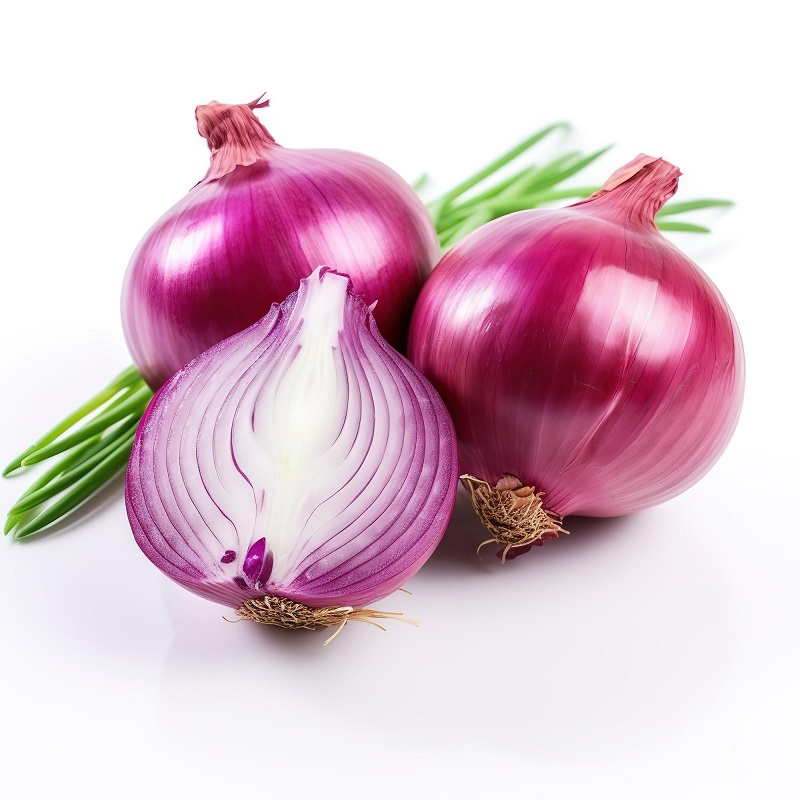Pakistan is the sixth biggest onion producer worldwide, making over 2 million metric tons each year. Most onions grow in Sindh province, making up about 40% of all onions in the country. Balochistan produces 33%, Punjab 16%, and Khyber Pakhtunkhwa province produces 11%.
Pakistan is fortunate to be able to grow onions all year round.
After the onion harvest season in Sindh, Punjab steps in to supply the markets. Later, as Punjab's supply decreases, onions from Khyber Pakhtunkhwa (KP) and Balochistan become available.
From June to November, three provinces—Sindh, KP, and Balochistan—keep providing onions to the markets.
When did the crisis start, and was there a decrease in production?
In November 2023, onions were priced at an average of 111 rupees per kg in Pakistan's vegetable markets. By December 2023, this had risen to 150 rupees, further escalating to 187 rupees in January 2024. In the first half of February, prices fluctuated between 195 to 215 rupees. In cities like Karachi, consumers were forced to pay between 250 to 300 rupees for onions, a situation that persists today.
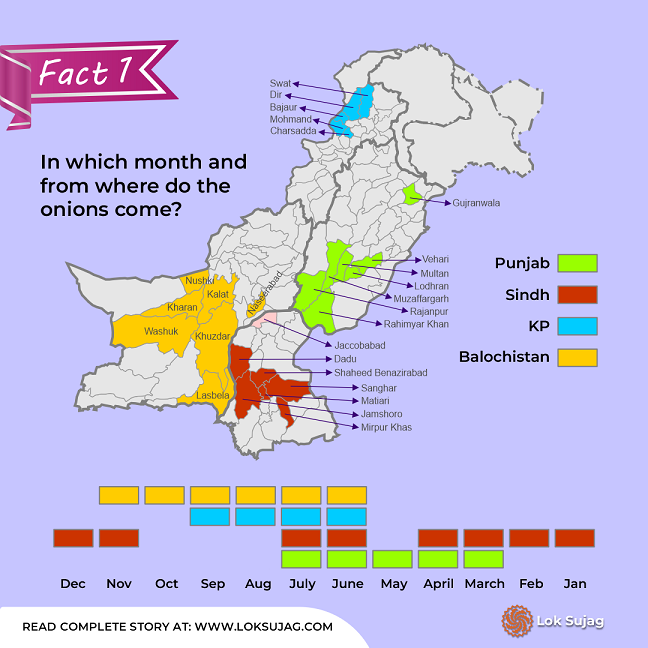
The surge in onion prices began in December 2023 with the arrival of crops from Sindh province in the markets. During this time, harvesting was underway in Jamshoro, Mirpur Khas, and Matiari, collectively accounting for around 17 percent of the country's total production.
In Pakistan, a typical family consumes around 53.82 kg of onions per year, which is more than 1 kg per week. With the current population and consumption rate per family, it's estimated that onion production would need to reach 2.06 million metric tons annually to meet the demand.
In the last three years, Pakistan has produced an average of 2.02 million metric tons of onions annually. This falls just a bit short of the annual requirement by 0.042076 metric tons. Such a small difference isn't enough to cause a sudden doubling of prices.
Over the last three years, Pakistan exported about 250,000 metric tons of onions and imported an average of 300,000 metric tons.
What prompted Pakistan to block the entry of Indian onions?
As per reports from Indian media, the central government has enforced a ban on onion exports starting from December 8, 2023, until March 31, 2024. This measure aims to address price stability concerns within the country, especially with adverse effects on onion production in major areas such as Maharashtra and Karnataka due to heavy rains.
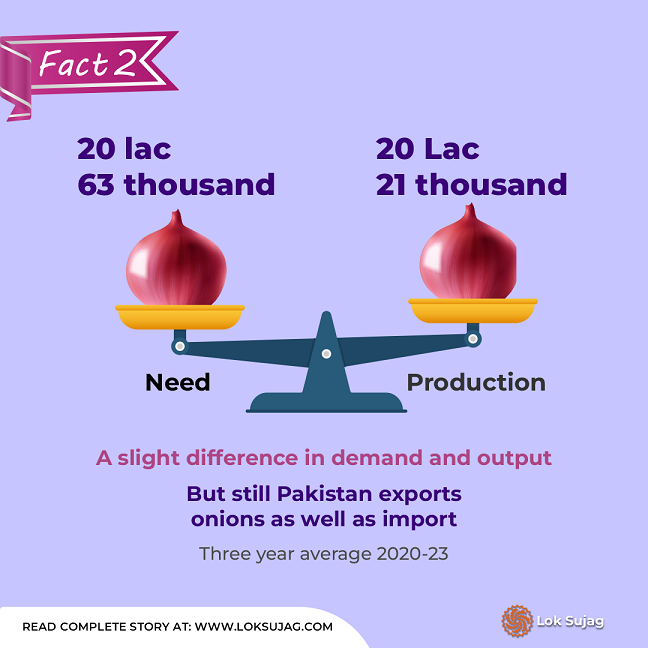
India ranks as the world's second-largest onion exporter, next only to the Netherlands, with an annual export volume of about 1.5 million tons. Based on 2020 statistics, India holds a 17 percent share of onion exports globally. Key importers of Indian onions include Bangladesh, Sri Lanka, Malaysia, the United Arab Emirates, Bhutan, Nepal, and the Maldives. The imposition of India's export ban led to an increase in onion prices in these countries.
After India's export ban, onion prices have soared in neighboring countries. According to a report from an Indian newspaper, prices have reached 700 Pakistani rupees in Maldives, 500 rupees in Bangladesh and Bhutan, and 400 rupees in Nepal.
Due to the ban on Indian onion exports, Pakistan experienced a rise in onion prices despite the absence of imports from India. In Lahore markets, the average price per kilogram of onions jumped from Rs 164 in November to Rs 250 in December.
As soon as India announced the export ban, traders in Lahore, Pakistan, quickly initiated onion exports, taking advantage of the high international market prices. This export activity contributed to a rise in onion costs at the local level.
Muhammad Shahzad Sheikh, Chairman of the All Pakistan Fruit and Vegetable Import, Export, and Merchant Association, acknowledges that India's ban on onion exports has driven up onion prices in Pakistan. However, he disagrees with Pakistan's extensive onion export practices.
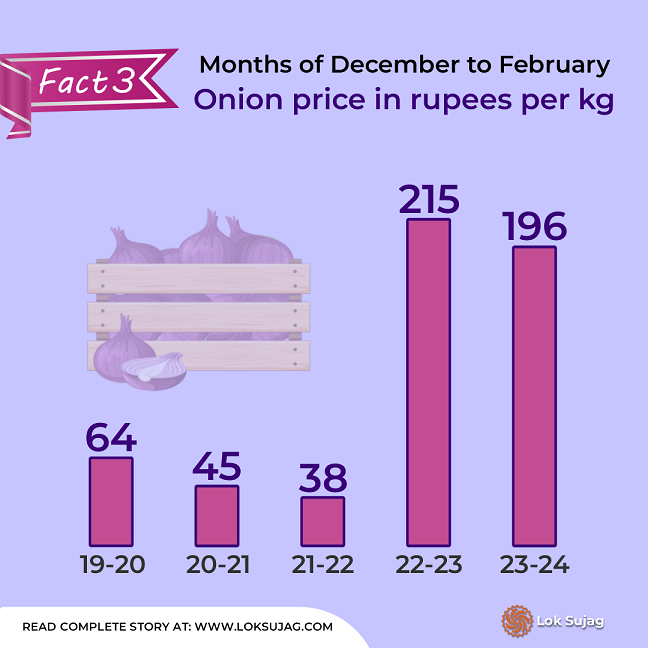
He underscores that Pakistan continues to export onions year-round, fulfilling orders since December. He attributes this trend to the enduring consequences of a flood that occurred one and a half years ago, which has led to reduced onion production in Sindh province.
However, the evidence contradicts Shahzad Sheikh's position.
According to an estimate, Pakistan has exported approximately 100,000 metric tons of onions in December and January combined.
Despite Pakistan's average annual onion export of 265,000 metric tons over the past three years, exporting 100,000 metric tons in just two months is considered a significant amount.
The export of onions from Pakistan has surged by nearly ten percent in the last three months, as confirmed by Imtiaz Hussain, the head of Imtiaz Enterprises, a leading onion trading company in Karachi. The high international market prices motivated exporters and farmers to capitalize on the opportunity, resulting in substantial profits.
He emphasizes that due to India's export ban; Pakistani businessmen have expanded their market reach to include countries like Mauritius, Maldives, and South Africa, alongside established markets such as Malaysia, the United Arab Emirates, and Sri Lanka.
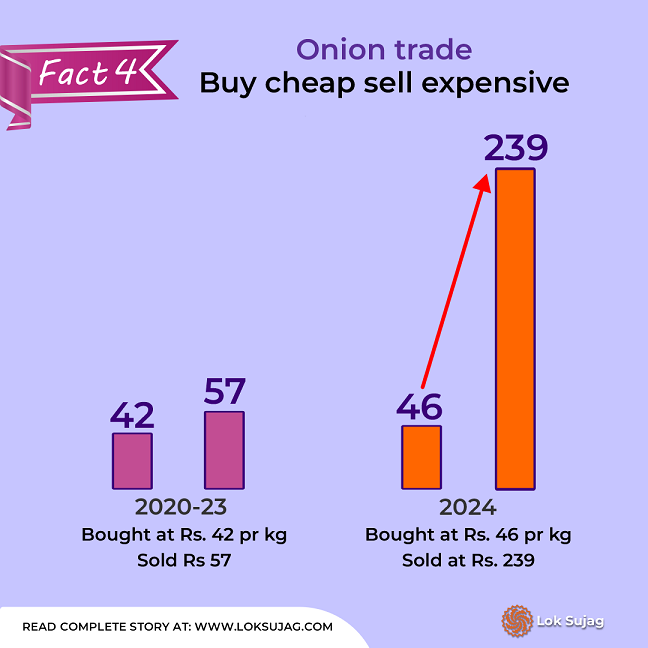
"We have also ventured into new import markets. Currently, a significant quantity of onions is being imported to Pakistan from Kazakhstan and Tajikistan via Afghanistan. This marks the first time Pakistan is importing onions from Kazakhstan, as previously, the country depended on Afghanistan, China, and Iran."
How does the political situation between Pakistan and Afghanistan influence the onion trade?
Muhammad Atif, a commission agent in Lahore's vegetable and fruit market, notes that typically, 50 to 60 vehicles loaded with onions arrive in Lahore daily. Some of these onions are distributed to other cities in Punjab.
"Currently, only 25 to 30 vehicles are reaching Lahore, each carrying around 25 to 30 metric tons of onions," Atif explains. "The disparity between supply and demand has led to a surge in onion prices in the Lahore market."
He highlights the challenges faced during onion transportation at the Afghanistan border. Additionally, he mentions that Iran has imposed a 40 percent excise duty on onion exports, resulting in a significantly reduced amount of onions being exported from there.
Haji Waheed, a Customs Clearance Agent at Torkham Border, verified that the number of vehicles arriving from Afghanistan has decreased. Instead of the typical 60-65 vehicles per day, now less than 40 vehicles arrive daily. Occasionally, this number drops even further to 20-25 vehicles per day.
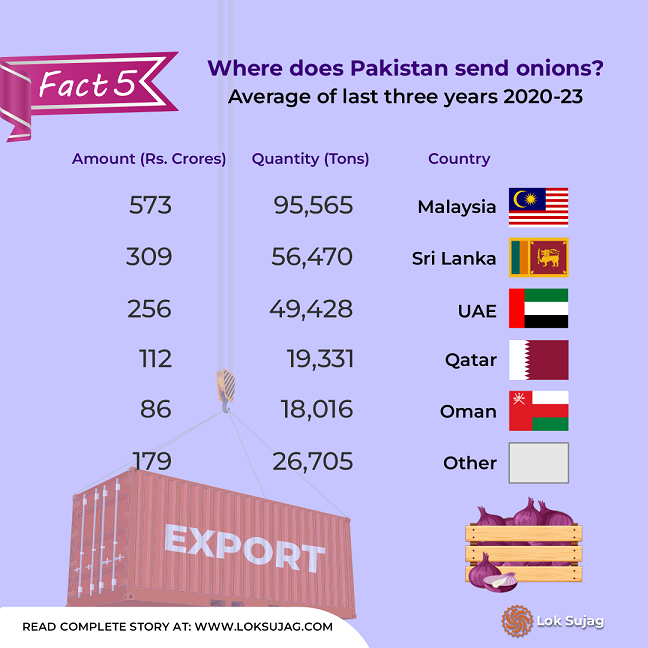
According to him, onion supply from Afghanistan to Pakistan is solely through the Torkham border. However, the uncertain political situation has imposed restrictions, leading to many vehicles being denied entry across the border.
Shahid Hussain, former president of the Chamber of Commerce Peshawar, asserts that the closure of the Torkham border is unjustified. Furthermore, the sluggish transfer of goods has resulted in vehicles being stranded on both sides for several days.
"Onions are perishable goods, leading to significant losses for traders. If trade of onions and other commodities between Pakistan and Afghanistan occurs regularly, it can prevent food shortages in both countries."
Despite all the challenges, Pakistan has imported around 150,000 metric tons of onions in December 2023 and January 2024, with the majority of imports coming through Afghanistan.
What happened to the onions produced in Sindh?
According to traders, the Trade Development Authority of Pakistan issued a notification on January 12, referencing the decision of the Ministry of Commerce, which also stipulated that export permission is subject to advance payment. This means that Pakistani traders will now be able to receive advance payment from foreign buyers.
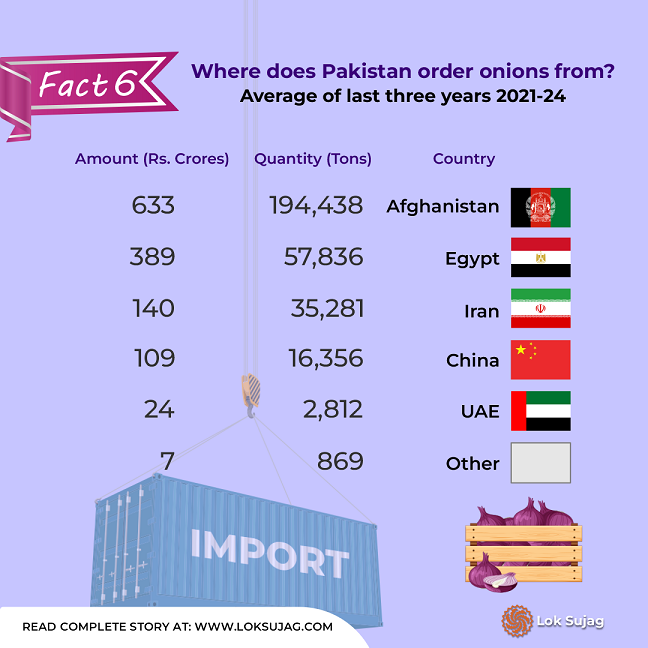
According to Imtiaz Hussain, the decision has drastically reduced exports. With only a few buyers in other countries making purchases out of necessity, the quantity of exports has decreased significantly.
Lahori trader Muhammad Atif contradicts Imtiaz Ahmed's statement, questioning why local onion prices haven't decreased despite a decline in exports.
He also mentioned a notable decrease in onion supply from Sindh this year. According to him, Sindh farmers are delivering their crops to Karachi markets, from where traders are exporting them abroad.
"The onions we're getting are not very good quality. Local traders are selling the lower-quality ones that are left after exporting the better ones."
He is worried that traders are importing onions from Afghanistan and then exporting them to other countries because their price is lower than that of Pakistani onions. The imported onions are priced at around Rs 46 per kg, while traders are exporting them at Rs 236 per kg.
What increase can be expected in onion prices during Ramadan?
According to the Federal Bureau of Statistics, onion prices in Pakistan have surged after January 12. On January 12, the price of onions in the Lahore market stood at Rs 185 per kg, climbing to Rs 225 by January 24. Traders in the Lahore vegetable market suggest that the rise in onion prices is due to increased stocking. They believe that hoarders are planning to take advantage of the upcoming Ramadan to earn profits.
Also Read
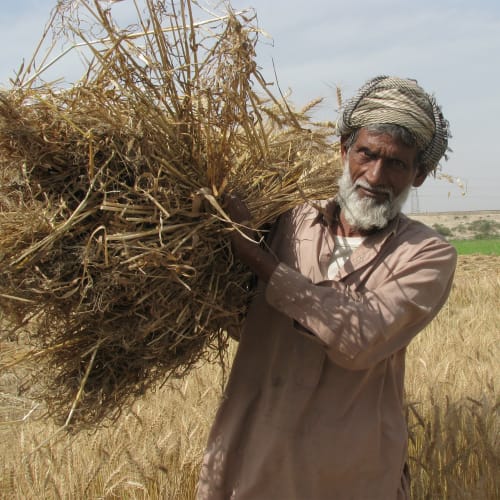
Manipulating the wheat market: 'Private traders are buying the crop for holding and smuggling'.
After India implemented a ban on December 8, observing the escalating onion prices in Pakistan, the caretaker government raised the export price of onions from $750 per ton to $1200 per ton with the aim of increasing onion exports and stabilizing prices.
However, this adjustment did not result in a significant decrease in costs. Nevertheless, a decline in onion prices was noticed when news broke on February 21 that the Indian government had granted temporary permission to Bangladesh, Mauritius, Bahrain, and Bhutan to export 54,760 tons of onions on a limited scale until March 31. This prompted the wholesale price of onions to plummet to Rs 137 per kg in just one day.
Joy and sorrow side by side
As onion prices have surged, urban consumers have expressed dissatisfaction, while farmers are content as they have received higher payments for their crops.
Abdul Majid Malkani, a prominent onion grower from the Badin district in Sindh, noted that when he began sending his onion crop to the markets on November 15, a 100 kg bag was fetching between Rs 4,500 to 5,000. However, immediately after India implemented a ban on onion exports on December 6, the price surged significantly, with the same bag of onions selling for 10 to 12 thousand Rupees.
He is delighted, as cultivating onions on 24 acres of land resulted in earnings of 12 lakh rupees for him.
Abdul Majeed is both a cultivator and a buyer of onions. He disclosed that while he used to send most of his crops to Punjab in the past, this time he only delivered one vehicle there. The rest was sent to Karachi.
"When exports are ongoing, you can fetch good prices in Karachi, and this time is no different."
Abdul Majeed draws attention to the recent drop in onion prices, attributing it to rumors spread by Karachi traders suggesting that India had lifted the ban to exploit farmers. He predicts that this price decrease is temporary and expects prices to rise further during Ramadan.
Muhammad Saleh, a farmer from Rojhan Tehsil in Rajanpur District of South Punjab, sold his two-acre crop in January for Rs. 14,000 per sack (100 kilos). Similar to Abdul Majid, he is also pleased with the significant profit he earned.
Published on 5 Mar 2024
